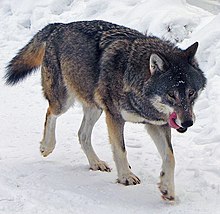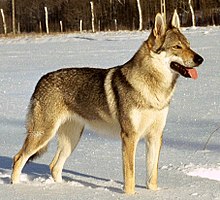
Diet
Wolves primarily feed on medium to large sized ungulates (sometimes 10–15 times larger than themselves[26]), though they are not fussy eaters. Medium and small sized animals preyed on by wolves include marmots, hares, badgers, foxes, polecats, ground squirrels, mice, hamsters, voles and other rodents, as well as insectivores. They frequently eat waterfowl (particularly during their moulting period and winter, when their greasy and fatty meat helps wolves build up their fat reserves) and their eggs.[94][95] When such foods are insufficient, they will prey on lizards, snakes, frogs, rarely toadsand large insects. In times of scarcity, wolves will readily eat carrion, visiting cattle burial grounds and slaughter houses.[94] Wolf packs in Astrakhan will hunt Caspian seals on the Caspian Seacoastline.[96] Some wolf packs in Alaska and Western Canada have been observed to feed on salmon.[97] Cannibalism is not uncommon in wolves; during harsh winters, packs often attack weak or injured wolves, and may eat the bodies of dead pack members.[98][99][100] However, they are not known to eat their young as coyotes sometimes do.[84] Humans are rarely, but occasionally preyed upon (see Attacks on humans).[101][102][103][104] Wolves will supplement their diet with fruit and vegetable matter; they willingly eat the berries of mountain ash, lily of the valley, bilberries, blueberriesand cowberry. Other fruits include nightshade, apples and pears. They readily visit melon fields during the summer months.[98] Wolves can survive without food for long periods; two weeks without food will not weaken a wolf's muscle activity.[35]
Hunting and feeding behaviours
Howling
 | |
| Problems listening to this file? See media help. | |
 | |
| Problems listening to this file? See media help. | |
Wolves howl to assemble the pack (usually before and after hunts), to pass on an alarm (particularly at a den site), to locate each other during a storm or unfamiliar territory and to communicate across great distances.[149] Howling consists of a fundamental frequency which may lie between 150 and 780 Hz, and consists of up to 12 harmonically related overtones. The pitch usually remains constant or varies smoothly, and may change direction as many as four or five times.[24] Wolves from different geographic locations may howl in different fashions; the howls of European wolves are much more protracted and melodious than those of North American wolves, whose howls are louder and have a stronger emphasis on the first syllable. The two are however mutually intelligible, as North American wolves have been recorded to respond to European-style howls made by biologists.[150]

No comments:
Post a Comment